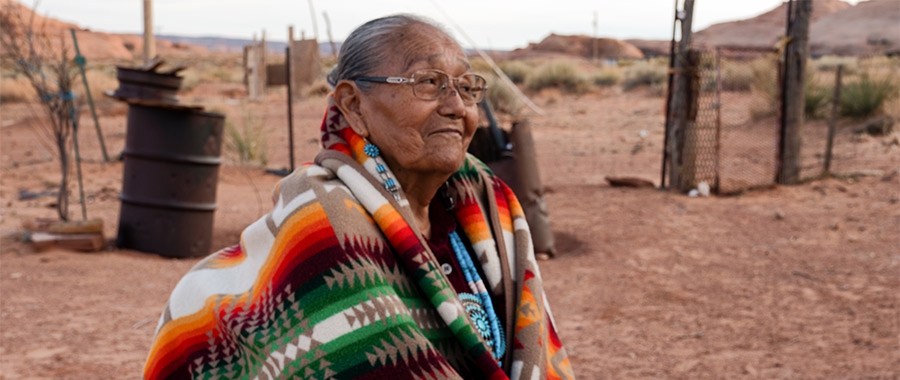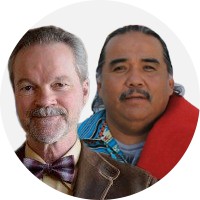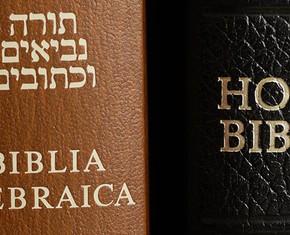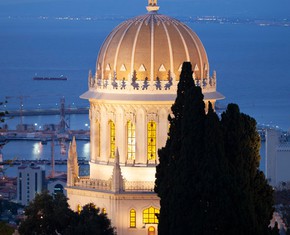The views expressed in our content reflect individual perspectives and do not represent the authoritative views of the Baha'i Faith.
The Navajo people have a deep, rich, extensive spiritual tradition, which relies on the Navajo creation story. That complex cosmology defines every Navajo’s relationship with all living creatures.
In the same way, the Baha’i cosmology – which reflects the oneness of all humanity – tells a story of harmony and unity:
O peoples of the world! The Sun of Truth hath risen to illumine the whole earth, and to spiritualize the community of man. Laudable are the results and the fruits thereof, abundant the holy evidences deriving from this grace. This is mercy unalloyed and purest bounty; it is light for the world and all its peoples; it is harmony and fellowship, and love and solidarity; indeed it is compassion and unity, and the end of foreignness; it is the being at one, in complete dignity and freedom, with all on earth. – Abdu’l-Baha, Selections from the Writings of Abdu’l-Baha, p. 1.
As a primary symbol of those unifying relationships, Navajo sand paintings hold deep spiritual meanings for the tribe, primarily because they reflect the content of the sacred ceremonies used by Navajo medicine men. In this continuing series of interviews with Navajo Baha’i Bitahnii Wayne Wilson, Christopher Buck asks about the deep meanings of the tribe’s belief system and how they relate to the Baha’i teachings.
Q: Greetings, Bitahnii Wayne! Do you know of any sacred Navajo/Diné chants associated with the “Rainbow and Corn Pollen Path” sand painting, which you told me about in our previous two articles?
A: The Blessing Way Ceremony! The “Rainbow and Corn Pollen Path” sand painting was used in the Hail Chant and Ceremony, too. A famous Navajo/Diné Medicine Man, the late Hosteen Klah, explained that there were three other sand paintings similar to the last and final sand painting, which is the one we spoke of.
Q: Yes, I understand that the notable Hosteen Klah (Hastiin Tłʼa, d. 1937) was also known for his weavings of sacred Navajo/Diné sand paintings – created and replicated from chants he knew. He made those weavings in order to preserve the sacred ceremonial chants traditionally recited during the performance of ritually creating each of these sand paintings.
Although this practice was contrary to the prevailing Navajo tradition of not creating permanent images of sacred sand paintings, Hosteen Klah decided to do so since there were not enough apprentices to whom he could teach his chants and thereby preserve the tribe’s traditions. So, by this ingenious and resourceful means, Hosteen Klah could help keep alive the chants associated with these sand paintings, as a living tradition, and prevent them from being lost. Of course, he did his very best to avoid offending the gods, whose spirits and power would be evoked in these permanent images.
In 1937, Hosteen Klah, together with the American anthropologist Mary Cabot Wheelwright, established the Museum of Navajo Ceremonial Art, known today as the Wheelwright Museum of the American Indian in Santa Fe – New Mexico’s oldest non-profit, independent museum – which hosts most of Hosteen Klah’s seventeen woven sand painting tapestries in its collection. Although he blessed the ground on which the museum is built, Hosteen Klah died a few months before it was completed.
Linda Covey, a Baha’i scholar who has done some important and valuable research in this area, has primarily focused on the Navajo Warrior Twins and on the Bab and Baha’u’llah as their return. Here’s Linda Covey’s Master’s thesis: Diné Becoming Baha’i: Through the Lens of Ancient Prophecies.
So, Bitahnii Wayne, by drawing attention to “Talking God” and “Calling God,” I think you are contributing something new to this discussion about the relationship of the Baha’i Faith and Navajo beliefs. I respect your knowledge and insight, so can you tell me more about the first “Talking God,” with whom you have associated the spirit of Baha’u’llah? As a young Navajo, what were you taught about “Talking God” and “Calling God”? Among these teachings, were there any prophecies that they would appear on earth in the future? Do other Navajo/Diné Baha’is, besides you, actually identify Baha’u’llah with “Talking God” and the Bab with “Calling God”? Or is this a fresh, original theory that you offer for the first time?
A: When I was little, there were many Chanters and Medicine Men. But now, very few remain. With the passing of those people, some sacred ceremonies have now become extinct, like the “Big Star Way” and the “Big God Way.” Many of our medicine men have passed on into the spirit world. Some of the remaining medicine men still do the ceremonial ways in their true form, but others have been lost.
So we’re experiencing a shift, where some of my people have become Christians and other denominations, and others, like me, have become Baha’is. We hold on to what seems close to the Baha’i way – and that is the Blessing Way and the Beauty Way, considered to be the life-way of the essence of who we are as Navajos. All the sacred Navajo/Diné Blessing Way and Beauty Way Chants come from “Talking God.”
Q: Can you tell us more about the Blessing Way and Beauty Way Chants?
A: In order to understand these chants, you have to really submerse yourself in the environment of that ceremonial setting for your spirit to truly understand what is being recited. It’s like you going back to the classroom or lecture hall in college as the professor is chanting the words over and over until you understand. Then you must take the final and recite the chant the exact way it was chanted to you.
Within these chants, it takes years or sometimes a lifetime for one to know, learn and understand the words – they are the words of Talking God and the Holy People, passed down for centuries in their original form. In order to truly grasp the spirit of the ceremony, one needs to attend – just as Baha’is are encouraged to go on pilgrimage to the Holy Land, across the ocean, to visit the Baha’i holy places.
As just one example, though, I know that the late Navajo Baha’i Annie Kahn stated that there is a Chant which explains the coming of the Bab and Baha’u’llah.
Q: Linda Covey identifies this as the “Unity Chant,” based on Annie Kahn’s interpretation:
In 1963, Navajo Baha’i Annie Kahn, one of the organizers of the Great Council Fire Unity Conference, wrote down for the first time the oral story of the Unity Chant given to her by her grandfather and the old “Holy Medicine Men” of the Navajo tribe. Annie writes in the Unity Chant that “He who is the All-Wise, the All-Knowing” brought something to the Navajo people “like a Holy Book,” except they couldn’t read or write at the time so the “Great One” gave it to them in chants. The Unity Chant says that a new light will come from the east to send its rays to those few Indians who are watching from the tops of the mesas. The “glorious new light” will be recognized by two signs. The first sign is a nine-pointed star whose points symbolize completeness and the love and unity of all religions, races, and nations. Annie explains that nine is the “sign of the highest unity because all the numbers can be found in this one number.” The nine-pointed star, one of three Baha’i religious symbols, is significant because the numerical value of [the word] Baha is nine.
The second sign instructs the Diné to look for a “great chief with twelve feathers” or “twelve great principles.” There are twelve basic principles in the Baha’i Faith. Annie writes that “if we search carefully we will find that these twelve principles of world unity have already come to the world and, even in this day, are beginning to bring people together in unity, understanding and love.” The Unity Chant also instructs the Navajo people to “look when they see the Glory coming.” Baha is the root word for Baha’u’llah and Baha’i, which translate, respectively, as “the Glory of God” and “follower of the Glory.” For Navajo Baha’is these images of glory connect Baha’u’llah to the “Great One” in the Navajo Unity Chant, who will “come like the dawn” and who “gathers His flock, bringing all the wandering sheep back together again.”
Annie quotes one of the Holy Medicine Men as saying that the “Time of the End” is like two stages: in the first stage the “Spirit of the People” shall live again and in the second stage “people shall melt into one,” meaning that “true love” between people will be practiced. Annie writes that the “love of the Great Spirit and of mankind that comes in the new day is so great that all the world’s afflictions and its dangers can in no way harm us.” – Linda S. Covey, “The Navajo Tradition—Transition to the Baha’i Faith,” Images, imaginations, and Beyond: Proceedings of the Eighth Native American Symposium, November 4–6, 2009, pp. 73–74.
















Comments
Sign in or create an account
Continue with Googleor